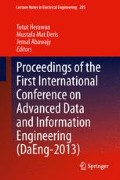Abstract
Collision is one of the major problems affecting the flow of pedestrian in a dense environment. The case study of this research work is the ground flow of Tawaf area (Mataf) at Masjid Al-Haram, Saudi Arabia. We propose a spiral model, that simulates the movement of 1,000 agents toward a unify direction while ensuring minimal collision among pedestrians during Tawaf. Based on our findings the spiral path movement is recommended for Tawaf movement. Several simulation trials were run. Outcomes such as average speed, duration and density were computed for different combination of spiral turn.
Access this chapter
Tax calculation will be finalised at checkout
Purchases are for personal use only
Preview
Unable to display preview. Download preview PDF.
References
Masjid Al-Haram Dataset, http://www.bdr130.net/vb/t87824.html
Curtis, S., Guy, S. J., Zafar, B., Manocha, D.: A Case Study in Simulating the Behavior of Dense, Heterogeneous Crowds. In: Computer Vision Workshops, IEEE International Conference, pp. 128–135, (2011)
Van den Berg, J., Snape, J., Guy, S., Manocha, D.: Reciprocal Collision Avoidance with Acceleration-Velocity Obstacles. In: IEEE International Conference on Robotics and Automation, pp. 3475–3482, (2011)
Qiu, F., Hu, X.: Modeling Dynamic Groups for Agent-Based Pedestrian Crowd Simulations. In: IEEE/WIC/ACM International Conference on Web Intelligence and Intelligent Agent Technology, pp. 461–464, (2010)
Nuhu, A. S., Faye, I., Simsim, M. T., Malik, A. S.: Spiral Path Simulation of Pedestrian Flow during Tawaf. In: IEEE International Conference on Signal and Image Processing Application, 13–17, Malaysia, (2013)
Alizadeh, R.: A Dynamic Cellular Automaton Model for Evacuation Process with Obstacles. In: Safety Science, pp. 315–323, (2011)
Varas, A., Cornejo, M. D., Mainemer, D., Toledo, B., Rogan, J., Muñoz, V., Valdivia, J. A.: Cellular Automaton Model for Evacuation Process with Obstacle. In Physica A: Statistical Mechanics and its Applications, pp. 382, 631–642, (2007)
Weifeng, F., Lizhong, Y., Weicheng, F.: Simulation of Bi-Direction Pedestrian Movement using a Cellular Automata Model. In Physica A: Statistical Mechanics and its Applications, 321, pp. 633–640, (2003)
Nishinari, K., Sugawara, K., Kazama, T., Schadschneider, T. A., Chowdhury, D.: Modelling of Self-Driven Particles Foraging Ants and Pedestrians. In Physica A: Statistical Mechanics and its Applications, 372, pp. 132–141, (2006)
Kirchner, A., Nishinari, K., Schadschneider, A.: Friction Effects and Clogging in a Cellular Automaton Model for Pedestrian Dynamics. In Physical Review E: Statistical, Nonlinear, and Soft Matter Physics, 21, pp. 056122/1–056122/10, (2003)
Helbing, D., Farkas, I., Vicsek, T.: Simulating Dynamical Features of Escape Panic. In: Nature, 407, pp. 487–490, (2000)
Zainuddin, Z. and Shuaib, M.: Incorporating Decision Making Capability into the Social Force Model in Unidirectional Flow. In: Research Journal of Applied Sciences, 5, pp. 388—393, (2010)
Zheng, X. P., Zhong, T. K., Liu, M. T.: Modeling Crowd Evacuation of a Building Based on Seven Methodological Approaches. In: Building and Environment, 44, pp. 437–445, (2009)
Asif, M., Malik, A. S., Tae-Sun, C.: 3D Shape Recovery from Image Defocus using Wavelet Analysis. In: IEEE International Conference on Image Processing, pp. 1025–1028, Genova, Italy, (2005)
Malik, A. S., Tae-Sun, C.: Finding Best Focused Points using Intersection of Two Lines. In: IEEE International Conference on Image Processing, pp. 1952–1955, San Diego, California, USA, (2008)
Malik, A. S., Shim, S., Tae-Sun, C.: Depth Map Estimation using a Robust Focus Measure. In: IEEE International Conference on Image Processing, pp 564–567, San Antonio, Texas, USA, (2007)
Malik, A. S., Tae-Sun, C.: Effect of Noise and Source Illumination on 3D Shape Recovery. In: International Journal of Pattern Recognition & Artificial Intelligence, Vol. 22, No. 5, pp. 945–958, (2008)
Author information
Authors and Affiliations
Editor information
Editors and Affiliations
Rights and permissions
Copyright information
© 2014 Springer Science+Business Media Singapore
About this paper
Cite this paper
Shuaibu, A.N., Faye, I., Malik, A.S., Simsim, M.T. (2014). Collision Avoidance Path for Pedestrian Agent Performing Tawaf. In: Herawan, T., Deris, M., Abawajy, J. (eds) Proceedings of the First International Conference on Advanced Data and Information Engineering (DaEng-2013). Lecture Notes in Electrical Engineering, vol 285. Springer, Singapore. https://doi.org/10.1007/978-981-4585-18-7_41
Download citation
DOI: https://doi.org/10.1007/978-981-4585-18-7_41
Published:
Publisher Name: Springer, Singapore
Print ISBN: 978-981-4585-17-0
Online ISBN: 978-981-4585-18-7
eBook Packages: EngineeringEngineering (R0)

